Alchemy as Leonardo’s Salvator Mundi sells for an astonishing US$450m
Nov 18th, 2017 | By Ivan Lindsay | Category: JournalIt is official, the young hot shots in Christie’s contemporary art department are marketing geniuses and in the art world is now operating in the post-truth era.
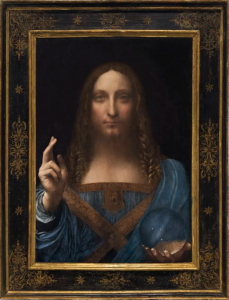
Leonardo’s Salvator Mundi just set a new world record for a painting costing its new owner an astonishing US$450,000,000.
Post-truth follows post-idea, a theory popular in liberal circles in the US that big ideas are no longer sought after and have become elusive. Ideas seem smaller, not because we are dumber than our ancestors but because we have shorter concentration spans to concoct or understand them. Only big ideas that can be fairly quickly monetized are considered worthy of effort. Logical argument and debate have lost ground to superstition and faith. Think of the Renaissance relapsing back into the Middle Ages.
Post-truth has filtered down from the top. No one believes what World Leaders say any more. People listen to them gently curious as to what might be behind what they are saying. An emotional response, based on instinct, has become more comfortable than a logical one.
The sale of ‘Leonardo’s’ ‘Salvator Mundi’ for US$450,312,500m (incl. commission) is a triumph of marketing over truth. Christie’s focused their marketing on an idea so that whoever bought the picture is buying into the idea of Leonardo, an artist so highly revered as a Renaissance man that it is hard to look at his work subjectively without the baggage that comes with his reputation…scholar, scientist, inventor, writer and so on.
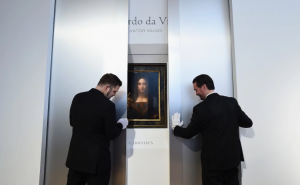
Christie’s security preparing the shrine like viewing area for the general public
Potential clients were shown a video of hundreds of people, including Leonardo di Caprio and Patti Smith traipsing past the painting, while bursting into tears and generally being overcome by what they saw. Of course these people were not really overcome by what was in front of them (a rather dopey and weird-looking Christ), but by the idea of Leonardo and how they felt they should respond. Jussi Pylkkanen, who took the sale, told those present that three kings, Charles 1st, Charles II and James II, had owned the painting. This statement may or may not be true but it was a perfect opening for the night and gave the painting the added lustre of a Royal provenance.

Leonardo di Caprio in the Christie’s video captured while contemplating the painting and perhaps his future role in the movie.
Presenting the painting as having definitely been in the Royal collection sums up Christie’s attitude towards the painting where they gave it the benefit of the doubt in every area. A legal statement at the beginning of the catalogue entry said there was a guarantee and appeared to say that Christie’s had some type of financial involvement in the painting. The provenance, condition, legal issues were all glossed over and the painting was presented as rock solid. This is a departure from their normal working practise that is more circumspect. Normally when a line of provenance is not certain they say ‘Possibly in the collection of’ or ‘Probably in the collection of’ etc. In their after-sale press release they state the painting was in the collection of King Louis XII of France as well, which was based on a speculative comment by Luke Syson of the National Gallery London and has no basis in fact. Earlier in the catalogue they had stated, “Luke Syson, in the catalogue to the exhibition, Leonardo da Vinci: Painter at the Court of Milan, has speculated that Leonardo may have made the painting for the French royal family and that it was brought to England by Queen Henrietta Maria when she married King Charles I in 1625.”
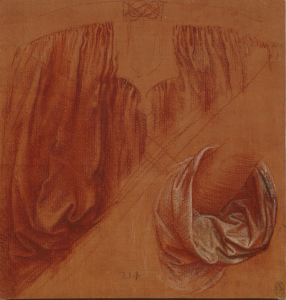
A study of drapery for a Salvator Mundi by Leonardo, c 1504, red chalk with pen and ink and white heightening on a plane red prepared paper, Collection of Queen Elizabeth II.
Christie’s follow this by saying, “What is known for certain is that it belonged to Charles I (1600-1649), the greatest picture collector of his age, and it is recorded in the inventory of the royal collection drawn up a year after his execution: “A piece of Christ done by Leonardo at 30:00:00” (£30).” Here Christie’s are just following the optimistic cataloguing of the dealers who owned the painting prior to its sale to Yves Bouvier. It seems odd that a hitherto unrecorded Leonardo was only mentioned for the first time in this inventory and was valued at pounds 30 when the other Leonardo in the collection, the ‘St John the Baptist,’ was valued at pounds 140. It may have been the Christie’s painting, that was just considered a school of Leonardo painting at the time, or it may have been a different version of this composition.
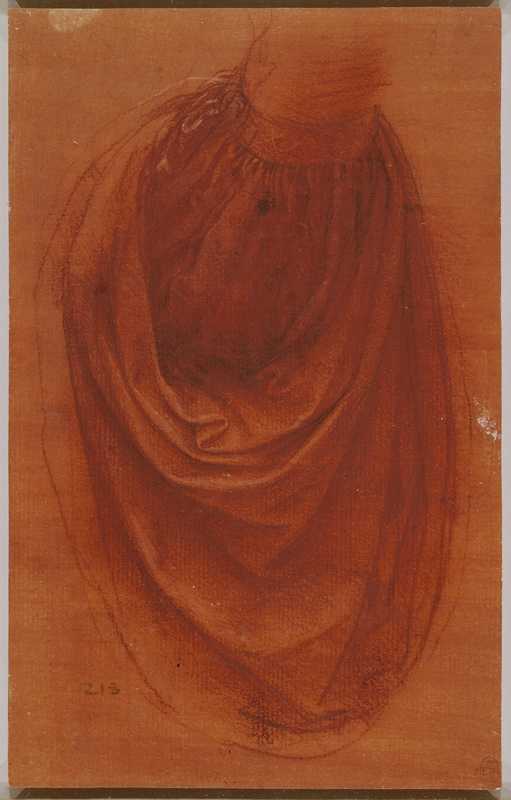
The second possible preparatory drawing by Leonardo in the Queen’s Collection.
Major paintings in Charles I’s collection are normally well documented. We find them in the inventories of the collections that Charles bought en bloc such as the collection of the Gonzaga dynasty in Mantua. Then we can follow them through the Commonwealth sales and their later history. According to Jerry Broton, Charles only had one picture which was considered a proper Leonardo, ‘St John the Baptist.’ In Broton’s exhaustive study of ‘Charles 1st and His Art Collection, the Sale of the Late Kings Goods (Macmillan, 2006),’ he makes no mention of a ‘Salvator Mundi’ by Leonardo ever being in the King’s Collection.
Charles had other Leonardo school works such as the painting attributed to Leonardo he was given by the Barberini family in 1635. He tried and failed to buy Leonardo’s work on other occasions such as in 1623 when Juan de Espinosa in Madrid declined to sell him the two books of Leonardo drawings now known as Codex Madrid I and II.
As an example of the detail we know of the important paintings in Charles’s Collection Leonardo’s ‘St John the Baptist’ had been part of an exchange between Charles and the Duc de Liancourt where Liancourt received a Holbein of Erasmus, and a Titian Madonna, for the Leonardo. After Charles’s death it passed, in lieu of a debt, to the Keeper of the Cabinet Room, Jan Van Belcamp, who died shortly afterwards. His estate sold it a French merchant called Oudancour (for pounds 140) who was buying on behalf of the dealer, Everard Jabach, who in turn was selling to Cardinal Mazarin. The painting then returned to France and is now in the Louvre.
Next piece of evidence offered by Christie’s is a 1650 engraving by Wenceslaus Hollar of a painting of this composition. Although the engraving doesn’t look much like the Christie’s painting, and closer resembles a Luini now in the Chiesa di San Bernadino in Naples, it is confidently presented as being a depiction of the painting. Of course Hollar says the painting he engraved is by Leonardo but at this date anything Milanese, and of Leonardo’s school (he has at least 15 pupils over his two Milanese periods), was given to the master himself.
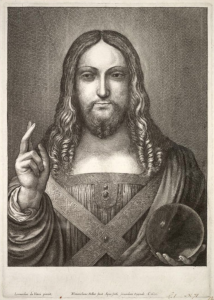
Wenceslaus Hollar’s engraving of 1650 which may or not be a depiction of the Christie’s painting
Hollar had fought for the Royalists and been captured at the siege of Basing House in 1645. He escaped and by 1646 was working in Antwerp where it known he met up with his old client, the Duke of Arundel. He stayed in Antwerp not returning to England until 1652. His engraving of the ‘Salavator Mundi’ was executed in 1650 so he cannot have had the painting in the Royal Collection in front of him. Christie’s get round this by suggesting he had made a drawing of the painting earlier (which is possible) and did his engraving of the painting from the drawing. More likely he had another completely different picture in front of him (like the Luini in the Chiesa di San Bernadino) that would explain why the engraving does not look much like the Christie’s painting.
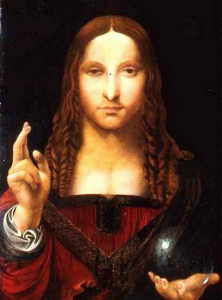
Salvator Mundi attributed to Bernadino Luini and now in the Chiesa di San Bernadino in Naples
The King’s picture worked its way through the Commonwealth sales with Christie’s saying, “An inventory records that the painting was sold at the ‘Commonwealth Sale’ on 23 October 1651 to John Stone, a mason (in modern terms an architect or builder) who was representative of a group of creditors who received it and other paintings in repayment of debts. Nine years later, when Charles II was restored to the throne and his late father’s possessions were recalled by an act of Parliament, Stone returned the painting to the Crown. A 1666 inventory of the collection of King Charles II at Whitehall lists it among the select paintings in the King’s closet, as item 311: “Leonard de Vince O.r. Savio.r w.th. a gloabe in one hand and holding up y.e other.” The picture very probably remained at Whitehall in the reign of Charles II’s successor, James II, passing to his mistress, Catherine Sedley, Countess of Dorchester (1657-1717), and by descent until the late 18th century.” Apparently the colorful but plain Catherine was bewildered when chosen by James to be his mistress saying, “It cannot be my beauty for he must see I have none,” …. “And it cannot be my wit, for he has not enough to know that I have any.” It seems unlikely that James would have given his mistress a painting from the Royal Collection that was considered to be a real Leonardo.
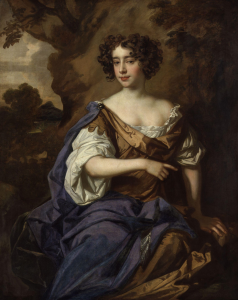
Catherine Sedley, later Countess of Dorchester, Mistress of James II and Restoration wit and libertine, by Sir Peter Lely in 1675.
There is no reason why Christie’s Contemporary art department should understand the weaknesses in any of this. The Old Master Paintings Department would have which is probably why they did not handle the sale. It is all a stretch. All that can be said for sure is that the King had a painting of this composition, which was most likely to have been by one of Leonardo’s followers, and this painting worked its way through the disposal of the King’s collection and re-entered the Royal Collection when Charles II was restored. It somehow descended down to Catherine Sedley before it disappeared. It may or may not be the Christie’s painting. And Hollar engraved a version of this painting which may or may not be the Christie’s painting. While the painting was in any of these collections no one ever considered it of any value or interest or discussed or mentioned it in which would be in keeping for a Leonardo school painting.
The Christie’s painting appears or reappears (if it is indeed the painting formerly in the Kings Collection) in 1900 when it was acquired by the collector Sir Francis Cook who displayed it at Doughty House, Richmond. Cook, born in 1817, died in 1901. From here we can be more sure of the provenance….. but not of who actually painted the picture.
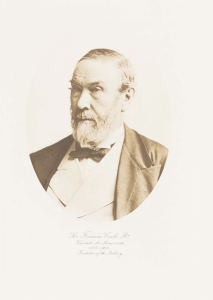
The businessman and collector, Sir Francis Cook, taken from the 1913 Catalogue of his famous collection. Cook, one of the three richest men in England, and a great collector, was the Chairman of Cook, Son and Co, a leading trader of wool, cotton, silk and linen at that time.
The definitive Catalogue of Cook’s paintings at Doughty House and elsewhere was published by Heinmann in 1913 with Tancred Boronius writing on the Italian Schools. Cook began collecting around 1860 at the same time as Lord Wantage, Robert Holford, and Sir Henry Layard. J. Pierpont Morgan and George Salting were a little later.
At the time of the 1913 Catalogue there were 476 paintings at Doughty House and good collections of glass, furniture, books and Oriental Objects. It was a fine collection with Boronius stating in his introduction, “The Giants of Art contribute to make the Gallery – Van Eyck, Durer, Rembrandt, Velasquez, Raphael, Titian, Rubens, Van Dyck, and Turner are all present.”
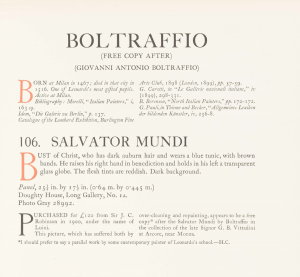
The Boltaffio Salavator Mundi entry from the 1913 Cook Collection Catalogue of the Italian School paintings complied by the Finnish art historian Tanced Boronius.
The Christie’s ‘Salvator Mundi’ is listed as No 106 but not illustrated. It is attributed as a, “Free copy after Giovanni Antonio Boltraffio,” a Leonardo pupil. It is described as, “Bust of Christ, who has dark auburn hair and wears a blue tunis, with brown bands. He raises his right hand in benediction and holds in his left a transparent glass globe. The flesh tints are reddish. Dark Background.”
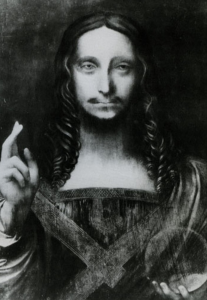
An image of the Christie’s painting believed to be taken at the time it was in the Cook Collection circa 1913.
A late addition to the Cook Collection the catalogue states it was purchased in 1900 for pounds 120 from Sir J.C. Robinson (1824 – 1913), the collector, scholar and curator who built up the collection of the South Kensington Museum which later became the Victoria and Albert Museum. Robinson sold it to Cook as a work by Bernadino Luini but Tancred Bornius reattributed it stating, “This picture, which has suffered both by over cleaning and repainting, appears to be a free copy after the Salvator Mundi by Boltraffio in the collection of the late Signor G.B. Vittedini at Arcore, near Monza.” Herbert Cook, the grandson of Sir Francis Cook, adds in a postscript in the catalogue, “I should prefer to say a parallel work by some contemporary painter of Leonardo’s school.” Both Tancred Boronius and Sir J.C. Robinson were specialists in Italian Renaissance painting at a time when the subject was much better known than it is today and it clearly did not cross either of their minds that this painting was by Leonardo.
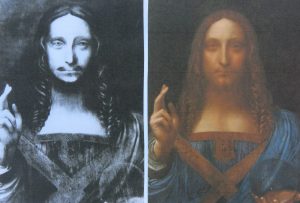
On the left an old photograph believed to be of the Christie’s Salavator Mundi when in the Cook Collection and on the right post Modestini’s intervention
Christie’s continue by saying Cook’s descendants sold it at an auction in 1958 for around pounds 45. In 2oo5 it was bought by a consortium of US-based dealers reputedly including Alexander Parish, Robert Simon and Warren Adelson, supposedly for under US$10,000 at an estate sale in Louisiana, and they, having cleverly authenticated it to Leonardo, sold it via Sotheby’s to Yves Bouvier in 2013 for approximately US$80m who in turn sold it on to Dmitri Rybolovlev for a reported US$127m.
By the time the painting was bought by the US dealers the condition, already described by Boronius in 1913 as bad, had worsened. The walnut panel had split and was patched together with stucco and glue. ARTnews reported, “it was a wreck, dark and gloomy.” The dealers gave it to the New York based restorer Dianne Modestini who removed the overpaint and skillfully restored the painting back into Leonardo using the Hollar engraving and the Windsor preparatory drawings as a template. Modestini took 6 years to Leonardo the painting into its current state of Leonardesque. And it is here that, perhaps allied to the amount of money that was being made and available for distribution, that reality seems to have evaporated and virtually everybody that came into the paintings orbit suspended their ability to look and started talking as if they were standing in front of the Mona Lisa herself.
It starts with Modestini herself. Quartz reported that “When the restoration was finally complete, Modestini says she fell into withdrawal, depression, and separation anxiety from seeing the painting move on. She likened the end of her restoration efforts to an emotional break-up: “It was a very intense picture and I felt a whole slipstream of artistry and genius and some sort of otherworldliness that I’ll never experience again.” When she realized the painting was by the master himself, “My hands were shaking, I went home and didn’t know if I was crazy.” Mmmm. Martin Kemp, the Leonardo scholar said, “He (Leonardo) draws you in but he doesn’t provide you with answers….it (the painting) has the uncanny strangeness that the later Leonardo paintings manifest.” Strange indeed.
According to Christie’s the list of scholars who are reportedly behind the painting’s new attribution includes Mina Gregori, Sir Nicholas Penny, Keith Christiansen, Carmen Bambach, David Ekserdjian and Everett Fahy. The general consensus was reached and a critical mass carried the majority along with them. One has to wonder whether these people have lost the ability to look and merely believe what they read or are told.
I first saw the painting in the exhibition ‘Leonardo da Vinci: Painter at the Court of Milan’ at the National Gallery in 2011. It looked odd and out-of-place hanging next to masterpieces such as the Lady with the Ermine from the Czartoryski Museum in Cracow. Christ looks dopey and weird and much of what you see is clearly by a restorer. The real mystery is how it came to be included in this exhibition, which conveniently secured the painting’s attribution from a commercial point of view, and allowed the sale to Rybolovlev to follow shortly afterwards. Prior to the exhibition one of the then owners, Robert Simon, reportedly told Bloomberg: “I’ve assured the National Gallery that the painting isn’t on the market and there are no plans to sell it after the exhibition.”
A more realistic overview of the provenance is as follows: –
- There are two drapery studies by Leonardo in the Royal Collection that are currently considered autograph that relate loosely to the composition of this painting.
- There are twenty or so studio versions of this composition
- Leonardo may have done an original but the prototype could also have been by a pupil
- Charles 1st owned a version of this picture
- Hollar engraved a version of this picture
- The Christie’s painting emerged from obscurity in 1900
The price trajectory: –
1650’s – pounds 30
1900 – pounds 120
1958 – pounds 45
2005 – circa US$10,000
2013 – circa US$80,000,000
2013 – circa US$127,000,000
2017 – US$450,312,500
- Pounds 45 in 1958 to US$450m in 2017 is a crazy ride, perhaps the craziest in art world history. The painting is at the centre of the enormous and ongoing legal battle between Bouvier and Rybolovlev….although perhaps Rybolovlev will now feel less aggrieved about Bouvier’s alleged US$1bn commission (made during Bouvier’s selling 38 paintings to Rybolovlev for US$2bn). It may even affect the lawsuit as it becomes harder for Rybolovlev to argue Bouvier was overcharging him. When he sells other valuable paintings in the collection such as the 4 Modigliani nudes he will surely come out ahead.
Whoever bought this painting has chosen to ignore, or more likely isn’t aware of the painting’s attribution, legal, condition and ownership problems. Or maybe they don’t care and are going to put the painting in a museum as a draw and believe the paintings controversy will only add to its appeal. Who has got this kind of money and would want a picture like this? Most Western buyers recoil from the paintings condition, questionable attribution and the fact that most of what you see is by a restorer. That leads to someone who has heard of Leonardo, is drawn to his mystique, and probably comes from another artistic tradition such as a Chinese or Arab client who can buy into the myth as opposed to the painting. There was also at least one Russian bidder. My guess is somewhere like the Louvre Abu Dhabi where it could provide the centrepiece of the newly opened museum in Saadiyat island. They currently have Leonardo’s ‘La belle Ferroniere’ on loan from the Louvre for a year, the first time a Leonardo has been seen in the Middle East. That will have familiarised them with the artist and seen what a draw he is. No doubt we will find out soon enough.

Saadiyat Island in Abu Dhabi
Of course the sale will probably generate another lawsuit in due course. The painting is already at the centre of the largest lawsuit in art world memory. The pictures recent history definitely warrants a movie and maybe that was running through Leonardo di Caprio’s mind as he admired the painting.
Christie’s small print says they guarantee their attributions for 5 years only. A lawsuit within 5 years could be bit awkward but the massive commissions generated, (reportedly circa US$50m alone to Christie’s), should cover the legal fees and after 5 years it doesn’t matter anyway.
Best of luck to the buyer but I see trouble ahead for them as this attribution will most likely not stand the test of time. I offer my congratulations to the dealers involved, the auction houses who sold the painting, whoever underwrote the U$100m guarantee, and most of all to Christie’s contemporary art department, who have proved that emotion, hype, marketing and the model they have developed for new buyers and artists such as Basquiat and Warhol is transferable to other markets such as Old Masters. We shall be seeing more of this in the future. On paper this was an impossible deal, akin to alchemy, wizardry and fairy dust, and although I don’t personally like the painting, I take my hat off to the chutzpah of those who managed to pull it off.

“Salvador Mundi” might not be a Leonardo’s masterpiece, but this masterful analysis could be considered as such.
Merci.
JLE